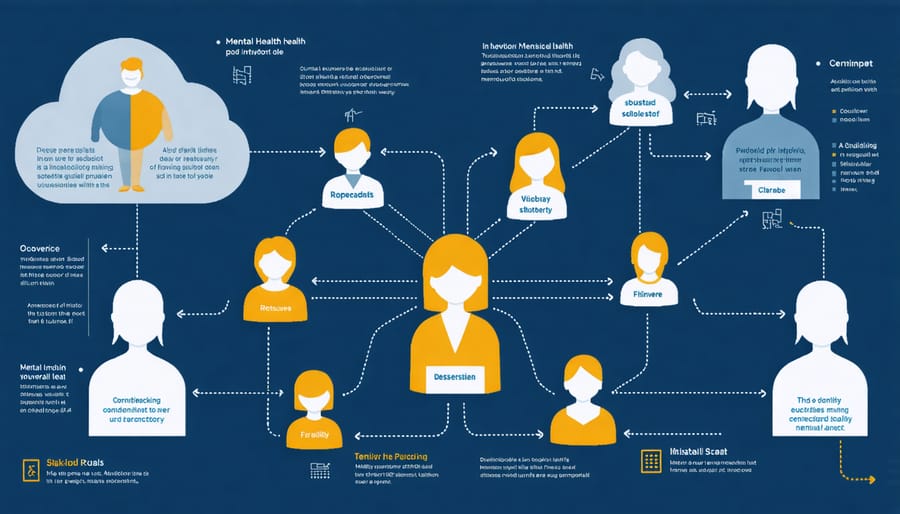Recognizing bipolar disorder in children requires careful attention to patterns that often look different from adult symptoms. While occasional mood swings are normal in children, persistent cycles of extreme highs and lows – lasting days or weeks – may signal bipolar disorder. Parents often notice their child alternating between periods of intense energy, decreased need for sleep, and risky behaviors, followed by episodes of withdrawal, sadness, or irritability.
Understanding this complex diagnosis starts with documenting your child’s symptoms, mood changes, and sleep patterns in detail. Work closely with a child psychiatrist who specializes in pediatric mood disorders, as they can distinguish bipolar disorder from other conditions with overlapping symptoms like ADHD or anxiety. Taking the right steps after diagnosis is crucial for developing an effective treatment plan.
Early identification and intervention make a significant difference in managing pediatric bipolar disorder. While receiving this diagnosis can feel overwhelming, remember that with proper medical care, family support, and appropriate interventions, many children with bipolar disorder lead fulfilling lives. The journey begins with accurate diagnosis and understanding the unique ways this condition manifests in young minds.

Understanding Your Child’s Diagnosis
Types of Pediatric Bipolar Disorder
Just as every child is unique, pediatric bipolar disorder can present differently in different children. Healthcare professionals typically recognize three main types: Bipolar I, Bipolar II, and Cyclothymic Disorder.
Bipolar I involves distinct manic episodes that may include increased energy, decreased need for sleep, and risky behaviors. These episodes can last for several days or weeks. Children with Bipolar I also experience periods of depression, though these aren’t required for diagnosis.
Bipolar II is characterized by less severe manic symptoms (called hypomania) but includes more prominent depressive episodes. Children might seem unusually happy or productive during hypomanic periods, but these changes are less disruptive than full mania.
Cyclothymic Disorder presents as frequent mood swings that are milder than those in Bipolar I or II but persist for at least one year in children. While these symptoms are less severe, they can still significantly impact a child’s daily life.
Some children may also experience what experts call “mixed episodes,” where symptoms of both mania and depression occur simultaneously. This can be particularly challenging for both children and their families to manage.
Common Symptoms and Behaviors
Children with bipolar disorder often display symptoms differently than adults, which can make diagnosis challenging. Common signs include intense mood swings that may shift rapidly, sometimes even within the same day. During manic phases, children might appear unusually energetic, talk excessively, have difficulty sleeping, or engage in risky behaviors without considering consequences.
During depressive episodes, children may become withdrawn, show changes in eating and sleeping patterns, or express feelings of worthlessness. Many parents notice their child becoming easily irritable or having frequent temper outbursts that seem out of proportion to the situation.
School performance often fluctuates, with periods of high achievement followed by significant struggles. Social relationships may become strained as mood changes affect interactions with peers and family members.
It’s important to note that these behaviors typically occur in distinct episodes and represent a marked change from the child’s usual behavior. Many children also experience physical symptoms like headaches or stomach aches during mood episodes. Some may express recurring thoughts about death or display aggressive behavior, particularly during manic phases.
Remember that every child is unique, and symptoms can vary significantly from one child to another. Regular observation and documentation of these behaviors can help healthcare providers make an accurate diagnosis.
Building Your Support Team

Mental Health Professionals
Selecting the right mental health professionals is crucial for accurately diagnosing and treating pediatric bipolar disorder. Start by seeking a child and adolescent psychiatrist who specializes in mood disorders. These specialists have extensive training in distinguishing bipolar disorder from other conditions that can present similarly in children.
Consider working with both a psychiatrist and a therapist. While psychiatrists focus on medical management and diagnosis, therapists provide essential emotional support and coping strategies. Look for professionals who have specific experience with children and bipolar disorder, and don’t hesitate to ask about their approach to diagnosis and treatment.
When evaluating potential providers, consider factors like their communication style, availability for emergencies, and willingness to collaborate with other healthcare providers and school staff. A good mental health professional should take time to thoroughly evaluate your child, gather comprehensive information from multiple sources, and explain their observations clearly.
Many parents find success by seeking recommendations from pediatricians, school counselors, or local mental health organizations. Remember that finding the right fit might take time, and it’s okay to meet with several professionals before making a decision. The ideal provider should make both you and your child feel comfortable, heard, and supported throughout the diagnostic process.
Trust your instincts – if you feel a professional isn’t taking your concerns seriously or isn’t connecting well with your child, it’s appropriate to seek a second opinion or alternative provider.
School Support Systems
Establishing a strong partnership with your child’s school is crucial for managing pediatric bipolar disorder effectively. Understanding the school’s role in mental health support can make a significant difference in your child’s academic success and emotional well-being.
Start by scheduling a meeting with your child’s teachers, school counselor, and administration to discuss your child’s diagnosis and needs. Create an individualized education plan (IEP) or 504 plan that outlines specific accommodations, such as extended test time, quiet spaces for emotional regulation, or modified homework assignments.
Maintain regular communication with teachers through email, phone calls, or a daily behavior log. This helps track mood patterns and identify potential triggers in the school environment. School counselors can provide valuable emotional support and serve as a safe person for your child during challenging moments.
Consider requesting that staff receive basic training about pediatric bipolar disorder to better understand and respond to your child’s needs. Many schools offer professional development opportunities focused on supporting students with mental health conditions.
Remember to update the school team about any medication changes or treatment adjustments, as these may affect your child’s behavior or performance in class. Working together creates a supportive environment where your child can thrive despite the challenges of bipolar disorder.
Treatment Options and Management Strategies
Medication Management
Medication management plays a crucial role among various treatment options for children with bipolar disorder. When prescribed appropriately and monitored carefully, medications can help stabilize mood swings and improve daily functioning.
Common medications may include mood stabilizers, such as lithium or certain anticonvulsants, which help regulate emotional ups and downs. Some children might also benefit from antipsychotic medications to manage more severe symptoms. It’s important to remember that medication plans are highly individualized, and what works for one child may not work for another.
Regular monitoring is essential to ensure the medication’s effectiveness and manage potential side effects. Your child’s doctor will likely schedule frequent check-ups to track progress and make necessary adjustments. These visits typically include monitoring vital signs, weight, and conducting regular blood tests when required.
Parents should maintain open communication with healthcare providers about any concerns or observed changes in their child’s behavior or physical health. Keep a daily log of symptoms, side effects, and mood changes to share during appointments. This information helps doctors make informed decisions about medication adjustments.
Remember that medication is often most effective when combined with other therapeutic approaches, such as psychotherapy and lifestyle modifications. Working closely with your healthcare team ensures the best possible outcomes for your child’s treatment journey.
Therapy Approaches
Several therapeutic approaches have proven effective in helping children manage bipolar disorder. Cognitive Behavioral Therapy (CBT) helps children identify negative thought patterns and develop healthy coping strategies. Through CBT, kids learn to recognize early warning signs of mood changes and develop action plans for challenging situations.
Family-focused therapy involves parents and siblings in the treatment process, improving communication and creating a supportive home environment. This approach helps families understand the condition better and work together to manage symptoms effectively.
Play therapy can be particularly beneficial for younger children who may struggle to express their feelings verbally. Through creative activities and play, therapists help children process emotions and develop self-regulation skills.
Group therapy offers children the opportunity to connect with peers facing similar challenges, reducing feelings of isolation. These sessions often combine educational elements with social skill development.
Many families find that a combination of these approaches, along with medication management, provides the most comprehensive support. Regular therapy sessions help maintain stability and provide ongoing tools for both children and their families to navigate the challenges of bipolar disorder.
Lifestyle Adjustments
Establishing consistent daily routines and creating a supportive environment can significantly help children with bipolar disorder manage their symptoms. Start by maintaining regular sleep schedules, as disrupted sleep patterns can trigger mood episodes. Set consistent bedtimes and wake-up times, even on weekends, and create a calming bedtime routine.
Structure meal times and ensure your child eats a balanced diet, as proper nutrition supports emotional stability. Regular physical activity, preferably at the same time each day, can help regulate mood and reduce stress. However, avoid over-scheduling, as too many activities can be overwhelming.
Create a quiet, organized space at home for homework and relaxation. Reduce sensory overload by minimizing loud noises, bright lights, and cluttered environments. Use visual schedules and calendars to help your child anticipate changes and transitions.
Monitor screen time and establish clear boundaries around device use, especially before bedtime. Encourage stress-reducing activities like drawing, listening to music, or gentle exercise when your child feels overwhelmed. Remember to maintain open communication with teachers and caregivers about these lifestyle adjustments to ensure consistency across different environments.
Supporting Your Child at Home
Creating a Stable Environment
Creating a stable, predictable environment is crucial for children with bipolar disorder. Dr. Sarah Chen, a child psychiatrist at Boston Children’s Hospital, emphasizes that “consistency and routine act as anchors, helping children feel secure and reducing mood fluctuations.”
Start by establishing regular daily schedules for waking up, meals, homework, and bedtime. Even on weekends, try to maintain similar patterns. For example, if your child goes to bed at 8:30 PM on school nights, aim for no later than 9:00 PM on weekends.
Create visual schedules using charts or calendars that your child can easily follow. This helps them understand what to expect throughout the day and reduces anxiety about transitions. Include positive routines like a calming bedtime ritual – perhaps reading together, gentle music, or quiet talk time.
Predictability extends beyond daily schedules. Keep your home environment organized and calm. Designate specific spaces for different activities: a quiet homework area, a cozy reading corner, and a safe space where your child can go when feeling overwhelmed.
Remember that while structure is important, some flexibility is necessary. Sarah Martinez, mother of a 12-year-old with bipolar disorder, shares, “We maintain our routines but also learn to recognize when our son needs a break. Having a backup plan helps us stay stable without being rigid.”
Monitor your child’s reactions to different environments and adjust accordingly. Some children may need more structure during challenging periods, while others might require gentle adaptations to their routine.

Communication Strategies
Having an open, honest conversation with your child about bipolar disorder is crucial for their understanding and well-being. Start by choosing a calm, comfortable moment when both you and your child are relaxed. Use age-appropriate language and explanations that they can easily grasp.
Begin by asking what they understand about their feelings and experiences. This creates a safe space for them to express themselves. Explain that bipolar disorder is like weather patterns in their emotions – sometimes sunny and energetic, other times cloudy and low – and that these changes aren’t their fault.
Focus on empowering your child by involving them in discussions about their treatment and coping strategies. Help them identify their emotions and encourage them to share when they notice changes in their mood or energy levels.
Use positive language and emphasize that having bipolar disorder doesn’t define them – it’s just one part of who they are. Share success stories of people who manage their bipolar disorder well, and remind them that many people live fulfilling lives with this condition.
Remember to be patient and maintain an ongoing dialogue. Your child may need time to process information and come back with questions. Reassure them that you’re always there to listen and support them through their journey.
While a diagnosis of pediatric bipolar disorder can feel overwhelming, remember that you’re not alone on this journey. With early intervention, proper support, and the right treatment plan, many children with bipolar disorder go on to lead fulfilling, successful lives. The key is taking action early and building a strong support network.
Start by working closely with mental health professionals to ensure an accurate diagnosis and develop a comprehensive treatment plan. Keep detailed records of your child’s symptoms, behaviors, and responses to medications or therapies. This information is invaluable for adjusting treatments and monitoring progress over time.
Remember to take care of yourself too – join support groups, connect with other parents facing similar challenges, and don’t hesitate to seek counseling if needed. Your emotional well-being is crucial for supporting your child effectively.
Focus on creating a structured, nurturing environment at home while maintaining open communication with your child’s school and healthcare providers. Small steps forward are still progress, and setbacks are a normal part of the journey.
With continued research advancing our understanding of pediatric bipolar disorder and new treatment options emerging, there’s more reason for hope than ever before. By staying informed, advocating for your child, and maintaining a positive outlook, you’re already taking important steps toward helping your child thrive.







